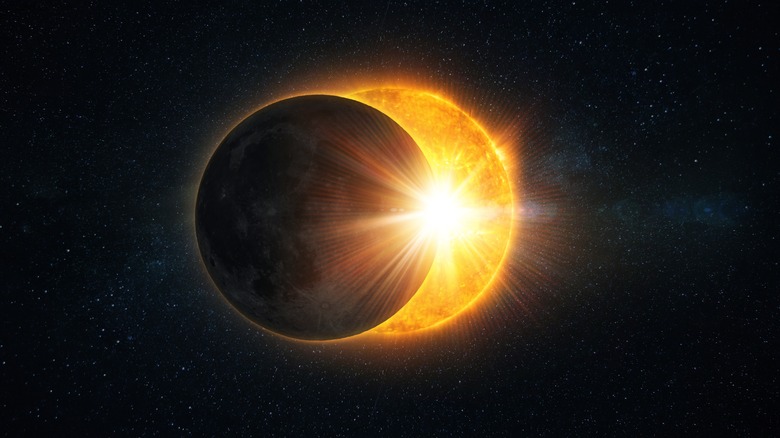What Happens To Your Solar Panels During An Eclipse?
For most of us, the upcoming solar eclipse on April 8 will be a fun day, with family and friends assembling outside and having a great time. Yet, for those working in the energy industry, the solar eclipse takes on a different significance. For them, it's not just a rare celestial event but also a unique opportunity to observe and understand the impact of eclipses on the electrical grid. So, you might wonder, what's the link between a solar eclipse and power generation? Are these seemingly unrelated fields intertwined in some way?
Well, until a few decades ago, when solar power generation was in its infancy, the connection between eclipses and power grids was tenuous at best. The focus was on the weather, with eclipses causing minor disruptions like sudden temperature and wind changes. But as the solar energy sector has boomed, so has the impact of eclipses on America's ever-reliable electrical grid.
Today, nearly 4% of the electricity consumed in the United States comes from solar energy, according to the U.S. Energy Information Administration. And while that might seem insignificant, it is big enough for grid operators in the country to plan for contingencies.
Will the solar eclipse have any impact on installed solar panels?
The solar eclipse only obscures the Sun for a couple of minutes and has no impact on the life of the solar panel installed on your rooftop, nor is it expected to cause any sort of indirect damage to it. You should instead be more concerned about natural calamities like tornadoes and hailstorms, which are significantly more dangerous for solar panel installations. Thankfully, there are several ways to keep solar panels safe from such problems as well.
Most concerns surrounding the solar eclipse and solar panels stem from the sudden reduction in the amount of electricity generated during the eclipse phase and the sudden return to normalcy once the eclipse is over. Under normal circumstances, the electrical grid is prepared for the predictable loss of power generated by solar panels once the Sun sets. This is quite unlike the solar eclipse scenario, wherein the drop in power and the return to normalcy happen within the span of a few hours during the day.
The last total solar eclipse in the U.S. from 2017 served as a test bed for electrical grid operators across the U.S. to test the reliability of the system. Thanks to the growth in solar power generation in the years since, the test is likely to be even tougher on April 8. However, since companies and operators have had enough time to prepare for this eventuality, we do not expect significant disruptions to the power grid in the U.S. on the day of the solar eclipse.
What effect will the eclipse have on solar power generation?
Grid planners in Texas estimate that the state would experience a staggering 90 percent reduction in its solar power during the eclipse, according to reporting from E&E. This is equivalent to the power needed for over 2.8 million homes. The eclipse's duration, during which the Sun will remain obscured for several hours — even in areas expecting only a partial eclipse — is a cause for concern. The resulting decrease in light falling on solar panels could lead to a minimum 50% reduction in solar power generation. This significant reduction underscores the magnitude of the challenge of maintaining a stable power supply during such events.
In the last total solar eclipse in 2017, an estimated 4,000 – 6,500 megawatts of electricity was cut as the eclipse reduced the amount of light falling on solar panels. Six years later, the amount of solar energy generated in the U.S. has more than tripled. Needless to say, the effect of reduced solar power generation for even a couple of minutes will have a sizable impact on the grid today.
Meanwhile, data shared by The Electric Reliability Council of Texas (ERCOT) indicates that in Texas, the solar eclipse could result in a significant reduction in the amount of solar-generated electricity. However, the agency adds that it has contingency plans to ensure that the electrical grid isn't affected by these sudden reductions and peaking of power.
Similarly, data provided by other grid operators from across the U.S. — even in states where the eclipse will only have between 50% and 75% coverage — indicate that the estimated shortfall from these areas will likely be less than 1,000 MW.


